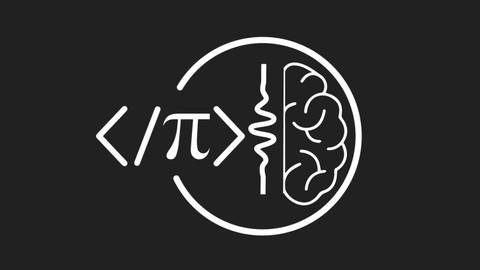
Complete neural signal processing and analysis: Zero to hero
Complete neural signal processing and analysis: Zero to hero, available at $94.99, has an average rating of 4.74, with 238 lectures, based on 1632 reviews, and has 9218 subscribers.
You will learn about Signal processing Time series data analysis Statistics (non-parametric) Neuroscience (brain science) Spectral analysis application Applied math This course is ideal for individuals who are Anyone interested in applied signal processing or Interested in non-parametric statistics or Existing or aspiring neuroscience students or Anyone who wants to know what brain electrical signals look like It is particularly useful for Anyone interested in applied signal processing or Interested in non-parametric statistics or Existing or aspiring neuroscience students or Anyone who wants to know what brain electrical signals look like.
Enroll now: Complete neural signal processing and analysis: Zero to hero
Summary
Title: Complete neural signal processing and analysis: Zero to hero
Price: $94.99
Average Rating: 4.74
Number of Lectures: 238
Number of Published Lectures: 233
Number of Curriculum Items: 238
Number of Published Curriculum Objects: 233
Original Price: $19.99
Quality Status: approved
Status: Live
What You Will Learn
- Signal processing
- Time series data analysis
- Statistics (non-parametric)
- Neuroscience (brain science)
- Spectral analysis application
- Applied math
Who Should Attend
- Anyone interested in applied signal processing
- Interested in non-parametric statistics
- Existing or aspiring neuroscience students
- Anyone who wants to know what brain electrical signals look like
Target Audiences
- Anyone interested in applied signal processing
- Interested in non-parametric statistics
- Existing or aspiring neuroscience students
- Anyone who wants to know what brain electrical signals look like
Use your brain to learn signal processing, data analysis, and statistics… by learning about brains!
If you are reading this, I guess you have a brain. Your brain generates electrical signals that can be measured using electrodes, which are like small antennas. These electrical signals are rreeeeeaaallly complicated, because the brain is really complicated!
But learning how to analyze brain electrical signals is an amazing and fascinating way to learn about signal processing, data visualization, spectral analysis, synchronization (connectivity) analyses, and statistics (in particular, permutation-based statistics).
What do you get in this course?
-
This course contains over 46 hours of video instruction, plus TONS of MATLAB exercises, problem sets, and challenges.
-
If you do all the MATLAB exercises, this course is easily well over 100 hours of educational content.
-
And you get access to the Q&A forum, where you can post specific questions about the course material and I answer as quickly as I can (typically 1-2 days).
-
By the end of this course, you will have confidence in processing, cleaning, analyzing, and performing statistics on brain electrical activity.
What do you need to know before joining this course?
I have tried to make this course accessible to anyone who is interested in learning neural signal processing and time series analysis.
I believe you can simply start this course without any formal background in neuroscience/biology, and without any background in signal processing/math/statistics. That said, some background in these topics will definitely be helpful.
However, I do assume that you have access to MATLAB (or Octave), and that you have some basic MATLAB coding skills (variables, for-loops, basic plotting). If you are a total noob to MATLAB, then please first take an intro-MATLAB course and then come back here.
Why should you trust this weird Mike X Cohen guy?
I’ve been teaching this material for almost 20 years. I’m really dedicated to teaching and I work really hard to improve my courses each year.
Check out the reviews of this course and my other courses to see what my students think of my teaching style and dedication.
I’ve also written several textbooks on neural data analysis and scientific programming. And there are more books and more courses on the way!
… but you have to watch out for my weird sense of humor. You’ve been warned…
Course Curriculum
Chapter 1: Introduction
Lecture 1: Broad introduction to neural time series analysis
Lecture 2: Neural data science as source sepatation
Lecture 3: What to expect from this course
Lecture 4: A quick note about how this went from 2 to 1 course
Lecture 5: Download this file if you are using Octave (otherwise ignore)
Chapter 2: The basics of neural signal processing
Lecture 1: Download MATLAB materials for this course
Lecture 2: Origin, significance, and interpretation of EEG
Lecture 3: Overview of possible preprocessing steps
Lecture 4: ICA for data cleaning
Lecture 5: Signal artifacts (not) to worry about
Lecture 6: Topographical mapping
Lecture 7: Overview of time-domain analyses (ERPs)
Lecture 8: Motivations for rhythm-based analyses
Lecture 9: Interpreting time-frequency plots
Lecture 10: The empirical datasets used in this course
Lecture 11: MATLAB: EEG dataset
Lecture 12: MATLAB: V1 dataset
Lecture 13: Where to get more EEG data?
Lecture 14: Simulating data to understand analysis methods
Lecture 15: Problem set: introduction and explanation
Lecture 16: Problem set (1/2): Simulating and visualizing data
Lecture 17: Problem set (2/2): Simulating and visualizing data
Lecture 18: Planck, neuron, universe
Chapter 3: Simulating time series signals and noise
Lecture 1: MATLAB files for this section
Lecture 2: Why simulate data?
Lecture 3: Generating white and pink noise
Lecture 4: The three important equations (sine, Gaussian, Euler's)
Lecture 5: Generating "chirps" (frequency-modulated signals)
Lecture 6: Non-stationary narrowband activity via filtered noise
Lecture 7: Transient oscillation
Lecture 8: The eeglab EEG structure
Lecture 9: Project 1-1: Channel-level EEG data
Lecture 10: Project 1-1: Solutions
Lecture 11: Projecting dipoles onto EEG electrodes
Lecture 12: Project 1-2: dipole-level EEG data
Lecture 13: Project 1-2: Solutions
Chapter 4: Time-domain analyses
Lecture 1: MATLAB files for this section
Lecture 2: Event-related potential (ERP)
Lecture 3: Lowpass filter an ERP
Lecture 4: Compute the average reference
Lecture 5: Butterfly plot and topo-variance time series
Lecture 6: Topography time series
Lecture 7: Simulate ERPs from two dipoles
Lecture 8: Project 2-1: Quantify the ERP as peak-mean or peak-to-peak
Lecture 9: Project 2-1: Solutions
Lecture 10: Project 2-2: ERP peak latency topoplot
Lecture 11: Project 2-2: Solutions
Chapter 5: Static spectral analysis
Lecture 1: Download MATLAB materials for this section
Lecture 2: Course tangent: self-accountability in online learning
Lecture 3: Time and frequency domains
Lecture 4: Sine waves
Lecture 5: MATLAB: Sine waves and their parameters
Lecture 6: Complex numbers
Lecture 7: Euler's formula
Lecture 8: MATLAB: Complex numbers and Euler's formula
Lecture 9: The dot product
Lecture 10: MATLAB: Dot product and sine waves
Lecture 11: Complex sine waves
Lecture 12: MATLAB: Complex sine waves
Lecture 13: The complex dot product
Lecture 14: MATLAB: The complex dot product
Lecture 15: Fourier coefficients
Lecture 16: MATLAB: The discrete-time Fourier transform
Lecture 17: MATLAB: Fourier coefficients as complex numbers
Lecture 18: Frequencies in the Fourier transform
Lecture 19: Positive and negative frequencies
Lecture 20: Accurate scaling of Fourier coefficients
Lecture 21: MATLAB: Positive/negative spectrum; amplitude scaling
Lecture 22: MATLAB: Spectral analysis of resting-state EEG
Lecture 23: MATLAB: Quantify alpha power over the scalp
Lecture 24: The perfection of the Fourier transform
Lecture 25: The inverse Fourier transform
Lecture 26: MATLAB: Reconstruct a signal via inverse FFT
Lecture 27: Frequency resolution and zero-padding
Lecture 28: MATLAB: Frequency resolution and zero-padding
Lecture 29: Estimation errors and Fourier coefficients
Lecture 30: Signal nonstationarities
Lecture 31: MATLAB: Examples of sharp nonstationarities on power spectra
Lecture 32: MATLAB: Examples of smooth nonstationarities on power spectra
Lecture 33: Welch's method for smooth spectral decomposition
Lecture 34: MATLAB: Welch's method on phase-slip data
Lecture 35: MATLAB: Welch's method on resting-state EEG data
Lecture 36: MATLAB: Welch's method on V1 dataset
Lecture 37: Problem set (1/2): Spectral analyses of real and simulated data
Lecture 38: Problem set (2/2): Spectral analyses of real and simulated data
Chapter 6: More on static spectral analyses
Lecture 1: MATLAB files for this section
Lecture 2: Program the Fourier transform from scratch!
Lecture 3: Program the inverse Fourier transform from scratch!
Lecture 4: Spectral separation on simulated dipole data
Lecture 5: FFT of stationary and non-stationary simulated data
Lecture 6: FFT and Welch's method on EEG resting state data
Lecture 7: To taper or not to taper?
Lecture 8: Extracting average power from a frequency band
Lecture 9: Comparing average spectra vs. spectra of an average
Instructors
-
Mike X Cohen
Educator and writer
Rating Distribution
- 1 stars: 3 votes
- 2 stars: 4 votes
- 3 stars: 75 votes
- 4 stars: 397 votes
- 5 stars: 1153 votes
Frequently Asked Questions
How long do I have access to the course materials?
You can view and review the lecture materials indefinitely, like an on-demand channel.
Can I take my courses with me wherever I go?
Definitely! If you have an internet connection, courses on Udemy are available on any device at any time. If you don’t have an internet connection, some instructors also let their students download course lectures. That’s up to the instructor though, so make sure you get on their good side!
You may also like
- Best Investing Courses to Learn in March 2025
- Best Personal Finance Courses to Learn in March 2025
- Best Health And Wellness Courses to Learn in March 2025
- Best Chatgpt And Ai Tools Courses to Learn in March 2025
- Best Virtual Reality Courses to Learn in March 2025
- Best Augmented Reality Courses to Learn in March 2025
- Best Blockchain Development Courses to Learn in March 2025
- Best Unity Game Development Courses to Learn in March 2025
- Best Artificial Intelligence Courses to Learn in March 2025
- Best Flutter Development Courses to Learn in March 2025
- Best Docker Kubernetes Courses to Learn in March 2025
- Best Business Analytics Courses to Learn in March 2025
- Best Excel Vba Courses to Learn in March 2025
- Best Devops Courses to Learn in March 2025
- Best Angular Courses to Learn in March 2025
- Best Node Js Development Courses to Learn in March 2025
- Best React Js Courses to Learn in March 2025
- Best Cyber Security Courses to Learn in March 2025
- Best Machine Learning Courses to Learn in March 2025
- Best Ethical Hacking Courses to Learn in March 2025






















